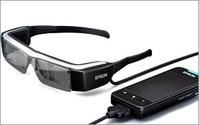
Epson showed off its second-generation smart glasses, Moverio BT200, at the Consumer Electronics Show in Las Vegas, revealing several new features. The glasses combine superimposed images grabbed
from the Internet on real-world images.
The glasses are slimmer, lighter and now support Android 4.0, Bluetooth, head-motion tracking, and Dolby Digital Plus. The previous design looked bulky and awkward. It required Epson to build a
marketplace to support Android apps.
Unlike Google Glass, the Epson glasses have a red light in full visibility when the camera records. On the lenses there are two mini transparent
displays. APX Labs designed new software to support the interface designed for productivity rather than fashion.
advertisement
advertisement
Epson said it will launch an app store for the BT-200, but consumers can also
download the apps from Google Play. Eric Mizufuka, product manager of Epson Moverio, told MediaPost last year the company would build a network of Android developers to develop and support apps for
the glasses.
Epson America also said it will become more active in location-based and wearable markets for fitness, health and sports to monitor a golf swing or heart rate. The company holds
more than 330 sensing-related patents worldwide. Juniper Research estimates that smart wearable device shipments will reach nearly 70 million units, with annual retail value of more than $8
billion by 2017. More than half of that forecast points to sports and fitness wearable devices.
CES will also debut other types of wearable glass technology. Innovega plans to release
iOptik -- special contact lenses that work as a filter allowing the human eye to focus simultaneously on things near and far -- as well as pull in information from the Internet, according to the
company. The company won contracts from the National Science Foundation and from DARPA mainly for simulation and training, but the company plans to move into consumer and other market segments.